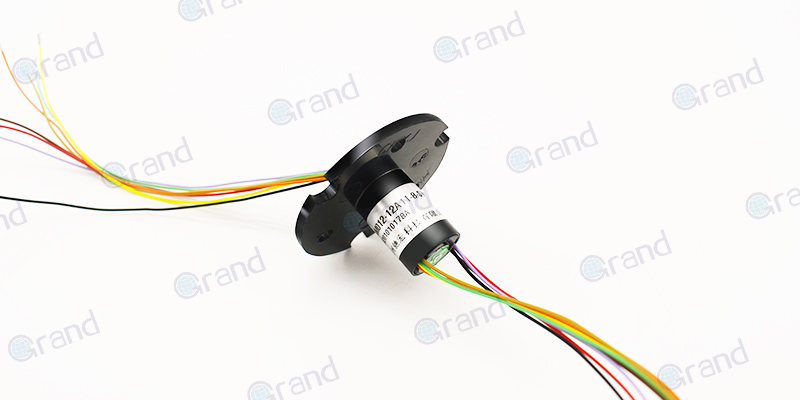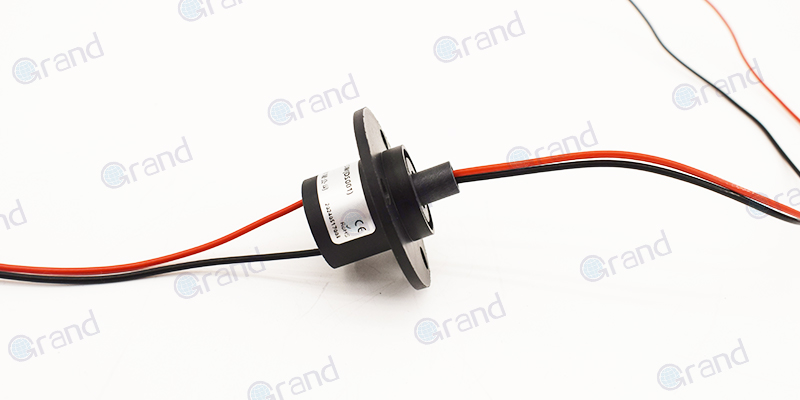In a world increasingly driven by precision and efficiency, the role of components such as strain gauge slip rings is paramount. Combining the capabilities of strain gauges and slip rings, these hybrid elements are instrumental in facilitating smooth operation in numerous applications.
Strain gauge slip rings are specially crafted devices that measure the strain (changes in size or shape due to applied pressure) in objects with a rotating reference frame. They accomplish this by integrating the precision of strain gauges with the stable connectivity provided by slip rings. This allows for the reliable transfer of data and power between stationary and rotating parts, making strain gauge slip rings indispensable in a host of industries such as engineering, aerospace, robotics, and testing labs.
Furthermore, these entities are fundamental to the efficient performance of many systems, and their coherent functioning hinges on the seamless operation of these components. By effectively managing the two critical tasks of strain measurement and data transmission, strain gauge slip rings emerge as key players propelling the applications they inhabit to new operational heights.
This article aims to provide a more in-depth exploration of strain gauge slip rings, their workings, applications, advantages, and more. Through this journey, we aim to cast light onto the myriad of ways in which they uniquely contribute to functionality across numerous fields and applications, thereby furthering our understanding of their significance.
Strain Gauges Slip Rings: Principles of Operation
To fully appreciate the role of strain gauge slip rings, it’s necessary first to delve into the principles of operation underpinning each of their components.
At the core of a strain gauge is the principle of electrical resistance, which varies according to the material’s strain (i.e., the change in dimensions when subjected to stress). Essentially, a strain gauge is constituted of a fine conductive filament arranged in a grid pattern. When this filament is subjected to strain, it distorts, causing a change in its electrical resistance. By measuring this variation, we can derive the precise quantities of stress or strain applied to the strain gauge.
On the other hand, a slip ring operates by facilitating electrical connectivity between stationary and rotating components. It comprises a set of electrically conductive rings and brushes. The brushes glide over the rotating rings, maintaining an electrical connection while allowing free rotation of the ring component. This mechanism is vital in applications where power or signal transmission is required across rotating parts.
When you integrate the sensitive measuring capability of strain gauges with the reliable connectivity of slip rings, you establish strain gauge slip rings. These specially crafted devices have the advantage of measuring strain in objects with rotating reference frames, while concurrently enabling transmission of power or signals without hindering the rotational movement. This unique partnership ensures strain gauge slip rings offer a coherent, efficient solution for various diverse applications.

Strain Gauges Slip Rings: Common Applications and Industries
Strain gauge slip rings find usage across a host of diverse sectors, showcasing their adaptability and wide-ranging practicality. These components are found wherever there’s a need for precision stress measurement in rotating machinery or equipment while transferring electrical signals or power.
In the aerospace industry, for instance, strain gauge slip rings are routinely used in test benches for jet turbines. The core requirement in these scenarios is the accurate measurement of stress without interrupting the rotational movement of the turbine, a task perfectly suited to strain gauge slip rings. They enable engineers to monitor stress levels on rotating parts of the plane such as propellers and turbine blades, these processes are critical to ensuring flight safety and maintaining mechanical integrity.
Engineering sectors often utilize these mechanisms in heavy rotating machinery. In wind turbines, strain gauge slip rings play an essential role in monitoring the strain on massive rotating blades and sending that data consistently to stationary monitoring systems for analysis.

Test labs and research facilities use strain gauge slip rings in a range of testing environments. Material testing, for instance, involves subjecting samples to varying forces and noting the strain profile. Here, strain gauge slip rings accurately measure and relay these strain values in real time, even in the most demanding rotational scenarios.
In the rapidly evolving field of robotics, strain gauge slip rings are widely used to measure the strain on robotic parts in motion, helping optimize robotic movement for efficiency and effectiveness. They ensure that data transfer between static and moving parts of the robot occurs seamlessly, leading to enhanced performance.

Across these varied industries, the use of strain gauge slip rings provides a well-integrated and coherent approach towards stress measurement and data transmission in rotating machinery, clearly demonstrating their irreplaceable value in such contexts.
Strain Gauges Slip Rings: Key Features and Benefits
The considerable value of strain gauge slip rings can be attributed to their unique features, which subsequently lead to a plethora of advantages in various applications.
Compact Size: Strain gauge slip rings are built to take up minimal space, ensuring they can fit into the most confined environments. This feature expands their applicability, allowing their integration even in situations where space is at a premium.
Long Life: Durability is an essential aspect of any mechanical component, and strain gauge slip rings are designed for longevity. Their construction and materials assure lasting operation, making them cost-effective choices for applications where consistent performance is crucial.
Maintaining Accurate Readings Over Time: The primary purpose of a strain gauge slip ring is to provide precise measurements. These devices are engineered to maintain the accuracy of readings, despite the passage of time, temperature fluctuations, or pressure variations.
These key features subsequently translate into several notable benefits, which make strain gauge slip rings an attractive option for various industries.
Improved Sensitivity: Strain gauge slip rings offer high sensitivity in their stress measurement, ensuring that even minor strains can be detected and monitored. This heightened level of sensitivity is ideal for applications requiring precision measurements to ensure performance efficiency and safety.
High-Precision Measurement Capabilities: Accuracy is of utmost importance in numerous industries, and strain gauge slip rings cater to this need with their ability to deliver highly precise strain measurements. Their consistent accuracy supports informed decision-making and operational adjustments based on real-time data.
Flexibility in Design: Strain gauge slip rings are adaptable in their design to meet diverse application-specific requirements. Depending on the environment, size constraints, and other crucial factors, these devices can be tailored to suit the functional needs of varied systems. This inherent adaptability renders strain gauge slip rings indispensable in numerous uniquely demanding scenarios.
Collectively, these features and benefits bring coherence to strain gauge slip rings’ context and contribute significantly to the strong reputation earned by these devices as reliable, accurate, and indispensable components across a multitude of applications.
Selection Criteria for Strain Gauges Slip Rings
In order to make an informed decision when selecting strain gauge slip rings, understanding the key factors that influence their performance is crucial. These selection criteria address specific aspects of the application and environment, ensuring an optimal match between the strain gauge slip ring and the system it is employed in:
Environment: The environment in which the strain gauge slip ring will operate significantly affects its performance. Considerations include temperature, humidity, and levels of dust or corrosive substances. For instance, certain alloys used in strain gauges exhibit higher sensitivity to temperature variations, while others are less affected. Similarly, waterproof and dustproof models may be necessary for certain environments to ensure seamless operation.
Size: The size constraints of the system in which the strain gauge slip ring will be incorporated should be evaluated thoroughly. Given their adaptable nature, strain gauge slip rings are available in various shapes and sizes, ranging from miniature to large, heavy-duty versions. This versatility allows you to pick the most suitable option that fits the spatial limitations of the system while not compromising on functionality.
Number of Circuits: The number of circuits needed for transmitting signals and power varies depending on the application, and this directly influences the choice of strain gauge slip ring. Consider the number of electrical connections required for your particular use case to ensure an appropriate strain gauge slip ring with adequate circuits is selected.
Mounting Options: The method in which the strain gauge slip ring is implemented within your system plays an essential role in its functionality and ease of use. Various mounting options, such as flange, through-bore, and end-of-shaft, are available to ensure seamless integration with the rotating components. Assessing the compatibility of the mounting technique with the system is essential for optimal performance.
Taking these factors into account when selecting a strain gauge slip ring guarantees a coherent and effective pairing with the intended application. The result is an optimized solution tailored to your system’s precise needs, fostering overall efficiency and success.
Strain Gauges Slip Rings: Installation and Maintenance
For strain gauge slip rings to function effectively and efficiently, meticulous attention must be paid to their installation and routine maintenance process. Consideration of these factors forms the basis for optimal performance and longevity.
Installing a strain gauge slip ring generally involves the following steps:
- Begin by preparing the mounting location in line with the guidelines provided by the manufacturer. The surface should be clean and handled cautiously to avoid any damage to the device.
- Place the strain gauge slip ring carefully onto the specified site and secure it in position according to the instructions given. Following the correct mounting technique (flange, through-bore, or end-of-shaft) is crucial at this stage.
- Once the slip ring is properly positioned, establish the electrical connections. Ensure the connections are securely fastened and insulated to prevent any electrical shorts or failures.
- After making sure everything is installed correctly, gently commence the rotational movement and observe its function. If any irregularities or problems arise, cease operation and consult the troubleshooting guide or seek professional advice.
Routine maintenance forms the crux of longevity and sustained efficient operation of strain gauge slip rings. Regular checks and cleaning are important to prevent debris accumulation that can obstruct the device’s function. Electrical connections should also be frequently inspected for signs of wear or corrosion and rectified accordingly. Temperature and humidity levels should be routinely monitored, as these factors could potentially alter the performance of the device.
Lastly, for checking and replacing strain gauge slip rings, follow a standard practice of routine inspection. Check the consistent accuracy of the measurements and observe for any physical or operational irregularities. If the device seems to be malfunctioning or displaying inaccurate results, it may be time to replace it. Always consult the manufacturer’s guidelines or a professional when replacing strain gauge slip rings, to ensure that the new device is installed correctly and is tailored perfectly to the needs of your system.
By adhering to these key installation and maintenance guidelines, strain gauge slip rings can perform optimally over prolonged periods, offering accurate measurements and configurations coherent with the intended applications.
Strain Gauges Slip Rings: Potential Challenges and Solutions
As with any piece of equipment, strain gauge slip rings are likely to encounter certain challenges in their operation. Familiarizing oneself with these potential issues and their solutions can help maintain the slip ring’s performance and longevity.
Thermal Instability: Fluctuating temperatures can cause thermal instability in strain gauge slip rings. This issue might result in inaccurate measurements due to voltage variances based on temperature. To mitigate this, consider selecting slip rings made of materials with a high degree of thermal stability, or integrate temperature controls and insulations to maintain a constant environment for the slip ring.
Moisture Interference: In particularly humid environments, moisture can infiltrate the slip ring resulting in signal interference or corrosion. To resolve this, it is vital to use slip rings designed to withstand high humidity levels. Employing protective casings and regular drying measures can help prevent moisture buildup, ensuring seamless operation.
Physical Wear and Tear: Over time, strain gauge slip rings can show signs of physical wear due to persistent rotation. Excess dust accumulation, frayed wires, or worn-out bearings may impair functioning. Regular maintenance and cleaning are crucial in these cases to keep the device in optimal condition. Also, consider employing strain gauge slip rings constructed from durable materials that can stand up to prolonged use.
Inconsistent Readings: A strain gauge slip ring might provide inconsistent or fluctuating readings due to several reasons, like improper installation, connectivity issues, or external interferences. In cases of inconsistency, checking the installation and connections for any shortcomings is recommended. If the problem persists, seek professional help or refer to the troubleshooting guide provided by the manufacturer.
Failed Electrical Connections: Oxidation or damage to the slip ring’s electrical connections can cause failure in transmitting signals or power. Regular inspections and cleaning of the connections, along with anti-corrosion measures, can ensure a prolonged lifespan of the slip ring.
Meeting these challenges with appropriate solutions demonstrates how understanding and implementing corrective measures can enhance the performance and longevity of strain gauge slip rings, keeping them in coherence with their application’s context.
Strain Gauges Slip Rings: Future Trends and Innovation
The realm of strain gauge slip rings is dynamically evolving, with continuous advancements in technology promising new horizons for its applicability and efficiency.
Material Enhancement: One crucial aspect under constant enhancement is the material composition used in the manufacturing of slip rings. The pursuit for more durable and temperature-resistant materials is ongoing. Future innovations in material science will focus on introducing alloys or composites capable of withstanding more rigorous operating conditions without compromising the accurate transmission of signals.
Improved Design: Further refinements to the strain gauge slip ring design are expected. Enhancements, including slimline designs for tight spaces and modular setups allowing for customizable numbers of circuits, are potential trends. Additionally, the development and integration of self-cleaning or self-lubricating mechanisms could further augment operational longevity and reliability.
Advanced Data Management: With the advent of big data and IoT, strain gauge slip rings may likely incorporate advanced data management features. This could involve predictive maintenance algorithms signifying when a part is due for replacement, thereby reducing downtime and improving overall efficiency. Furthermore, real-time data analytics and wireless data transmission are features that could possibly be integrated into future designs.
Environment-Friendly Solutions: With the growing emphasis on sustainability, future strain gauge slip rings might focus more on minimizing environmental impact. This could include utilizing recyclable materials in production, increasing energy efficiency, or creating designs that reduce waste generation during their lifecycle.
Integration of Sensors: To enhance the capabilities of strain gauge slip rings, the integration of various sensors could become commonplace. This may include temperature, humidity, and pressure sensors that can provide real-time data and adjustments to ensure optimal performance under varying conditions.
As discussed, the future holds promising advancements for strain gauge slip rings that will make them even more reliable, versatile, and easy to use. These innovative trends will undoubtedly expand their applicability and improve their coherence within their respective application contexts.
Conclusion
In summary, strain gauge slip rings play a pivotal role across various industries. Their precise measurements and reliable function offer invaluable benefits. As the technology continues to evolve, so does the potential of strain gauge slip rings, making them an intriguing field to watch in the future. Innovative solutions to their challenges and continued enhancements paint a promising picture for these vital components’ journey ahead.
FAQs about Strain Gauges Slip Rings
To help users understand strain gauge slip rings better, here are answers to some frequently asked questions concerning their usage and functionality:
Q1: What is the principle of operation of a strain gauge slip ring?
A1: Strain gauge slip rings operate on the principle of producing a change in electrical resistance proportional to the degree of strain experienced by the device. This function allows for precise measurement and transmission of data related to the stress endured by the system in which the slip ring is implemented.
Q2: How do temperature changes affect strain gauge slip rings?
A2: Temperature fluctuations can impact the accuracy of a strain gauge slip ring’s readings. High temperatures can potentially alter the device’s resistance, leading to variations in output. Therefore, it’s essential to consider the device’s thermal stability or add temperature control mechanisms to ensure accurate and consistent readings.
Q3: What maintenance is required for strain gauge slip rings?
A3: Regular maintenance of strain gauge slip rings is crucial for their longevity and efficient functioning. This may include cleaning to avoid debris buildup, regular inspections for wear and tear, and checking on the integrity of electrical connections. Maintaining an optimal operating environment is also essential to prevent issues like moisture interference or thermal instability.
Q4: When should I consider replacing my strain gauge slip ring?
A4: Signs such as inconsistent readings, continuous operation issues, or visible wear and tear might indicate that it’s time to consider replacement. Always refer to the manufacturer’s guidelines or consult with a professional to determine the appropriate timing for replacement.
Q5: Can I use a strain gauge slip ring in a high-humidity environment?
A5: While standard strain gauge slip rings can face challenges in high-humidity environments, there are models designed specifically to withstand such conditions. When choosing a slip ring for such an application, ensure the device features waterproof or moisture-resistant properties.
See What We Can Do

